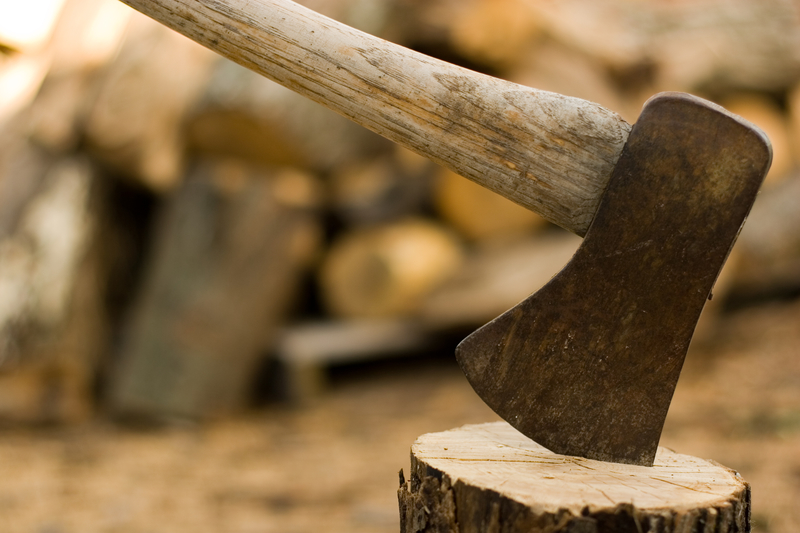Even though we’re not in the midst of winter, the warm months are the ideal time to start perfecting those axe-wielding skills. By the time fall comes around, you feel confident in your ability to create a sustainable source of wood that can be used for everything from fires to cooking.
1) Felling
Determine the lean of the tree to be felled by viewing it from a distance two directions: front and 90º to the side. Hold/hang the end of your ax handle between your thumb and forefingers and use it as a plumb line to sight the tree’s lean. This will help you determine the lay or path the tree will fall.
Before Your First Swing
- Visually check the tree for any widow makers (dead limbs) that might dislodge and crash onto your body. Eye protection is advisable.
- Clear your swing radius of all debris that might snag your ax mid swing.
- Predominant wind direction and gusts can be your friend or foe when felling trees.
- Have multiple escape routes. Be ready to drop everything and retreat if need be.
Swing Stance
Position your body so that your feet are behind the chopping strokes and to the outside of your feet. Chopping stokes should be outside the “train tracks” (two parallel lines running to the outer edges of your boots) with your feet inside the tracks on flat ground.
Face Cut
Aim to make a 45º face cut near the base of the tree. This notch should go about halfway through the tree and be perpendicular with the imaginary line of fall. Accuracy is more important here than strength and power.
Never swing in an upward manner to remove wood chips in the notch. Continue making 45 degree cuts from top to bottom of the face cut. Decreasing your swing angle slightly to about 10º will help remove chips… just never swing upward!
Back Cut
This cut needs to be a 45º notch with its shelf an inch or two higher than the face cut shelf. This height difference creates a “hinge”.
The hinge serves as a safety device to prevent kickback when the tree begins to fall.
Use the same cutting strokes as you did with the front cut. As you close in on the front cut from the rear, pay attention to the trees movement. After that, it’s time to get out of the way and let gravity take over. Unlike how I demonstrated on the video below…
2) Limbing
Limbing can be dangerous since there is no backup to stop the ax once it severs the branch. Here’s some tips for limbing safely:
Swing in a direction from the base (trunk) to the top of the downed tree. This removes the limb even at the trunk leaving little to no snags.
Start by removing limbs from the topside of the downed tree to prevent them from interfering while limbing side branches. Remember to keep your feet inside the “railroad tracks” and the limb outside the tracks on all horizontal swings. Once severed, remove to keep your work area clear for side limbing.
Keep the tree trunk between you and the limb you are removing when at all possible. Keep your body slightly behind the target limb as you swing.
3) Bucking
Bucking is the process of chopping logs into manageable lengths for conveyance. If you know the length of your ax, use it as a measuring tool to lay out the log sections to be bucked.
Bucking tips:
- Scotch the log with wooden wedges or smaller branches on both sides of the log to be bucked.
- Stand on top of the log with feet straddling your cut mark. Spread feet about shoulder’s width apart with knees and hips slightly flexed.
- Swing accurately and begin making “V” notches from the center of your mark to a width equal to the diameter of the log.
- Once you’ve notched one side of the log, turn and repeat the notching on the log’s opposite side. The two V notches will meet in the middle of the log and break apart.
4) Splitting
Splitting both short and long bucked logs will be covered more thoroughly in our next post in this series. Here is a post from last year that will give you a few safety tips on spitting wood.
Do you have other axe skills one should know? Do you have experience with any of these techniques?
Article Source: Survival Sherpa
